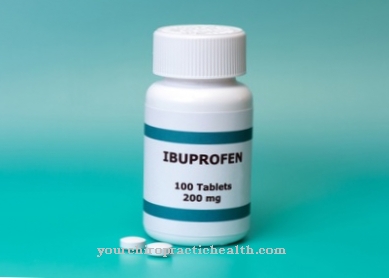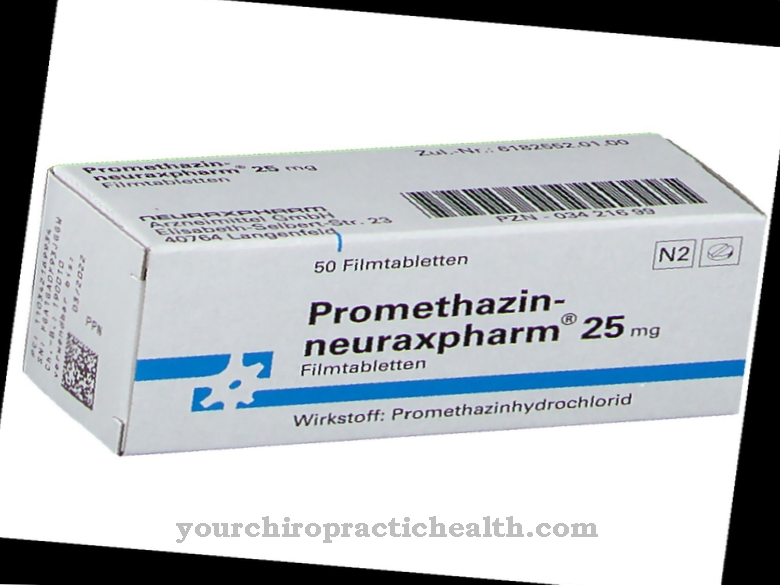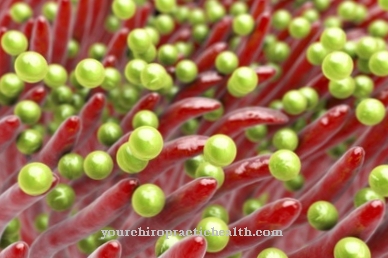At Pergolide is an active ingredient that is isolated from naturally occurring fungal alkaloids and is approved as a therapeutic agent for Parkinson's disease. It is also used in veterinary medicine to treat equine disease. Pergolide acts on the receptors of the neurotransmitter dopamine.
What is pergolide?

Pergolide has the molecular formula C19H26N2S and is a dopamine agonist. The active ingredient is formed by a hose fungus that lives as a parasite on certain types of grain. The ergot alkaloid is related to ergotamine, which is used to treat acute, long-lasting migraine attacks.
Pergolide drugs are used as a single preparation for the long-term therapy of Parkinson's disease (primary and secondary syndrome). Parkinson's disease is a mostly age-related, neurodegenerative disease that progresses slowly. In the incurable disease, mainly the nerve cells of the substantia nigra die. It is located in the midbrain. Your nerve cells are responsible for producing the neurotransmitter dopamine.
The most important symptoms of Parkinson's disease are muscle tremors, muscle rigidity and even immobility, slow movement and unstable posture.
Pergolid is available in Germany under the trade name Parkotil® and in Austria and Switzerland as Permax®. There are also various generics of the Parkinson's medication.
Since the active ingredient can cause many side effects, especially with combination therapy, the patient must be regularly monitored by a doctor (blood pressure control, ECG, etc.) before starting treatment and during therapy.
Pharmacological effect
Pergolide belongs to the group of dopamine agonists and binds very strongly to proteins present in the blood. Dopamine agonists dock on dopamine receptors and mimic their effects, so that the neurotransmitter is released. Pergolide binds to the D2 receptors.
Dopamine is responsible for controlling the motor skills in the body. If a stimulus is to be transmitted from one nerve cell to another in the brain, the sending nerve causes dopamine to be released. The neurotransmitter immediately docks with the dopamine receptors of the receiving nerve. There an electrical impulse is triggered that is passed on by the nerve. This enables the patient to walk, stand up, grip or perform other movements more freely again.
Drugs containing pergolide are prescribed as monotherapy for patients with Parkinson's disease in the early stages. Later, the drug is usually used together with the classic Parkinson's drug levodopa and a decarboxylase inhibitor. This is intended to support the positive effect of pergolide - it inhibits tremors and rigidity in movement - on the D2 dopamine agonists.
Since the agent does not affect the adrenaline and serotonin receptors, the risk of psychological impairment from pergolide is very low. When used with L-dopa and a carboxylase inhibitor, the dose can be slowly reduced. This also makes levodopa more tolerable for the patient.
Medical application & use
Pergolide is available as tablets in doses of 0.05, 0.25 and 1 mg. Combination therapy is usually only used when the drug alone is not effective enough. As a monotherapy, it is only a second choice.
The tablets are taken according to the doctor's instructions and dosed gradually from the start of treatment in order to keep the risk of side effects as low as possible. Alternatively, the patient can take 0.05 mg pergolide once a day for the first two days. For the next 12 days, he increases his daily dose every three days by two or three additional 0.25 mg. Then 0.25 mg pergolide is added every three days until the correct daily dose is reached.
From the third day onwards, the daily doses are distributed in several individual doses. In combination therapy, the daily amount of L-Dopa intake is reduced in parallel. Pergolide is taken whole before, with or after a meal.
You can find your medication here
➔ Medicines to calm down and strengthen nervesRisks & side effects
Pergolide should never be prescribed during pregnancy or while breastfeeding. In breastfeeding women, the active ingredient inhibits the production of prolactin in the pituitary gland. In addition, the substance and its breakdown products can possibly pass into breast milk. Young mothers should therefore either stop breastfeeding or discontinue the drug. If the patient is dependent on pergolide, she should avoid becoming pregnant for the entire duration of treatment.
Pergolide should never be used if the patient has severe kidney and hepatic insufficiency, severe cardiac arrhythmias and other serious heart diseases such as pericardial effusion and myocarditis.
In addition, the drug must never be prescribed to children and adolescents. If you absolutely have to take it, you should exercise particular caution in traffic, as you may suddenly fall asleep. If you have chest pain and shortness of breath, it is advisable to see a doctor immediately.
Since pergolide is usually taken together with levodopa and a carboxylase inhibitor, the side effects cannot be precisely differentiated from one another. The patient may experience disturbed movement sequences (dyskinesia), nausea, vomiting, sleep disorders, diarrhea, constipation, low blood pressure, poor appetite, palpitations, cardiac arrhythmias, kidney and liver dysfunction, rhinitis, shortness of breath, double vision and a short-term increase in liver values.
Fibrotically altered heart valves were found in more than every fifth Parkinson's patient. In rarer cases, pergolide can cause hallucinations and confusion. The use of dopamine agonists such as pergolide may aggravate or weaken other medications taken at the same time.

.jpg)






.jpg)



















